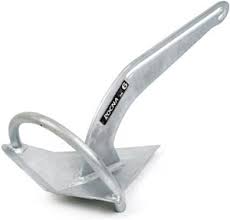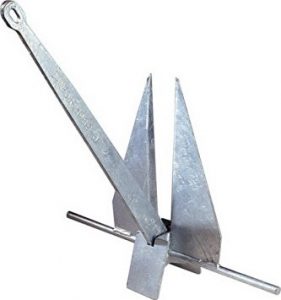Anchoring – This is a chance to be pilloried, which I suppose I should not miss.
We use a nylon rode when we anchor. In layman’s terms, we use a nylon rope to anchor when the current fashion is chain.†††
Everything in life is influenced by fashions of the times often with scientific facts to back up the fashion, and many times with someone making money from the fashion.
In boat design, for forty years or so, racing measurement rules and handicaps, drove boat design, and for no particular reason greatly influenced cruising boats. Our own Caro Babbo has the sail rig it does because of IOR (International Ocean Racing) ratings and PHRF handicap rules.
Our rig has a rather short boom and most of the drive comes a 135% genoa – 100% is the size of the triangle formed by the deck, the mast and forestay. The standard jib on Caro Babbo is 135% of that triangle, which was the fashion, driven by the IOR rules.
In recent years, regard for racing rules and PHRF rating has been largely discarded in boat design and especially in marketing reviews. No longer does a sailboat review list the boat’s ratings. Cruising boats now commonly use a much longer boom and larger main relative to previous boats and to the fore triangle. A 95% jib has allowed the use of self-tacking jibs, so tacking becomes merely a matter of turning the wheel.
There are a number of drivers for this change. In the seventies, boats were additionally marketed based on the number of people they could sleep. With hollowing of the middle class and income disparity, sailboats are more often marketed to older couples who have large disposable incomes. Technology, which makes navigating a video game, also allows 60+ footers to be marketed to these retired couples. Price tags are in the low seven-digits.
What has this to do with anchoring?
There is fashion here, also.

Until the Rocna anchor came on to the market, the ‘‘in fashion’’ anchor was the plow-type anchor. Delta was the best known. Very good holding power and set quite well.
It had the additional advantage that the design was could be copyrighted. A copyrighted design protects marketing dollars, so a copyrighted anchor can be promoted.
A Danforth anchor by contrast is a great anchor and in some settings is better than the copyrighted anchors. The problem with a Danforth is that the design is in the public domain.

A Danforth manufacturer can advertise the quality of its manufacturing (which is very important), or features like fluke angle adjustment, but when all is said and done, a Danforth is an anchor that anyone can manufacture.
Somewhere along the line, chain for anchoring became the fashion. I’m not sure when or how.
Chain is very expensive, very heavy, it rusts and has no elasticity. The last becomes its biggest failing, but chain is the fashion.
The two major advantages to chain, to my way of thinking is that it is very abrasion resistance, and because it is so heavy it keeps a boat from swinging in light winds.
Why do we use a Nylon rode?
These are the advantages we see:
It’s light. Two hundred feet of half inch weigh about 20 pounds.
The same amount of 5/16 in chain will weigh about 200 pounds. In modern sailboats the chain is stored in the bow. In our boat that is a shift of about 2% of the weight. To put this in perspective, a modern performance-oriented car places the battery where the weight of the battery will have the least effect on the car’s performance – In the trunk (boot) for a front engine car, under the hood (bonnet) for a rear engine car. The weight percentage is about the same.
The effect is large enough that more traditional sailboats store the chain in the middle of the boat, down low, generally in the bilge, so it won’t effect the sailing characteristics.
Aside from its very real resistance to abrasion, which is particularly important when anchoring near coral heads, chains is touted for its catenary effect. Catenary is the droop caused by the weight of the chain. When wind pushes against the boat, the pull lifts some of the chain so there is no shock to dislodge the anchor or tear apart the boat. This is where the argument falls apart.
It doesn’t take a lot of wind to lift the chain off the bottom. A recent article in Yachting Monthly showed, via inspection, rather than via mathematics, that a force four breeze will lift the chain off the seabed.
Once the chain is lifted of the seabed enough to tension it, the catenary effect disappears: there is nothing to absorb shocks from waves or wind gusts.
In the very nice book, Less than Walking Speed, the author’s nine-year cruise come to an un-foreshadowed end when the snubber on her anchor chain fails.
The lack of shock absorbency literally tears her boat apart, and her voyage ends in a few minutes.
The sailing community understands that chain has no stretch, so once the chain is tight, some sort of shock absorber must be added to keep the anchor from popping loose, or if the anchor holds, the boat from being torn apart.
The amount of shock absorber recommended has been growing in recent years. The recommendation now seems to be nylon line equal to the length of the boat, used as a bridle and latched onto the chain, so the chain hangs loose from the boat.
Chain is too expensive to discard when it starts to wear. As chain is used, the normal wear and tear grinds through the galvanization and the chain needs to be re-galvanized. Nylon line is discarded.
Just like there is cheap untrustworthy chain – Many articles are written about no-name chain – there is cheap untrustworthy nylon line. Neither has an advantage over the other in that regard.
The last thing that comes into my calculus is looking at the professionals here in Alaska and BC.
The professional fisherman use rode, not chain.
We find fishing boats tucked into corners when the day ends, not into harbors or coves, just bites out of the swell and large winds. They use a heavy woven rode with a length of chain. I need to ask whether the rode is nylon, as I assume it is.
At one time boats used metal cable. None of the boats I looked at have metal cable.‡ Nordic Spirit, that I wrote about in May 2016, used a woven rode.
The major problem with nylon rode, which comes when anchored amongst boats that use chain, is swing. We run into this problem particularly at the Wooden Boat Festival in Port Townsend.
With the weight of the chain hanging below, a boat that uses an anchor chain does not swing as easily as a boat using nylon rode.
Caro Babbo will always swing the full length of her rode with the pull of the tidal current – no wind necessary.
A boat using an anchor chain will not move much unless there is significant wind. Then, it moves the same as a nylon-rode boat.
In tight anchorages this is a problem. We solve it in Port Townsend, where we normally anchor in less that 30 feet, by putting down 60 feet of chain rather than the 30 feet we normally put down. This minimizes our swing.
This raises the question, why do we put down 30′ of chain rather than some other length. For this, I must confess, I don’t have a good answer.
For our 26-foot Thunderbird sailboat, I only used six feet.
Tests have shown that the less chain used the faster the anchor sets.
It short I have no justification for using a length of chain equal to the length of the boat. It has been recommended, but no article that I’ve read that suggests this length offers any justification.
I’m following the herd on this.
I started this article talking about anchoring and copyrighted designs.
Caro Babbo came with a Delta plow-style anchor. They set very quickly, but it has been pointed out that a plow design plows through the bottom. A Danforth, as an example, digs deeper as it is pulled until some sort of equilibrium is obtained.
When the opportunity came to purchase a new anchor*, I bought a Rocna. The Rocna is designed to dig in rather than plow over the bottom. The manufacturer claims it will set in its own length and that setting is not even necessary. (We do set the Rocna.)
The manufacturer also claims the Rocna resets† better than any other anchor. In general, we found this all to be true, though the Danforth seems better at resetting in weedy bottoms††.
What tips the Rocna over the Danforth are two items: (1) I have bought into the idea that the hoop on the Rocna helps it reset better, (2) Danforths do not mount on the bow of a boat very well and they are not self-launching.
I must also admit the intense loyalty and testimonials from people I meet also weighed in the Rocna’s favor. They seem very heavy duty. I have seen the flukes on a Danforth bend when pried off the bottom.
The Rocna’s scoop design digs in well. Because it does not have a large amount of surface area, it pries easily off the bottom.
(We do not have a windlass on Caro Babbo. Using a nylon rode permits this. We have only twice needed to use a winch to raise the Rocna.)
In summary:
Chain is so heavy it upsets the trim on a modern sailboat. Nylon line is very light.
Chain has no elasticity and can literal tear apart a sailboat if the snubber fails. Nylon has 10% elasticity.
Chain has very good abrasion resistance. Nylon abrasion resistance is not good; nylon line must be protected from abrasion. Snubbers on chain are often times nylon and do abraid through.
Because chain is so common, it is a problem that boats that use a nylon rode swing differently than those that use chain.
Chain requires a windlass. While I lift our anchor by hand, on a much larger boat, this would not be feasible even with a nylon rode.
I’m very interested in comments, so please comment.
*The story of the opportunity is still too embarrassing to tell. With the passage of time, I expect the embarrassment with fade and I will write the story, which I hope will be instructive in terms of maintenance.
† Resetting – The anchor is set with the boat pulling against the anchor. When the wind or current changes the position of the boat relative to the anchor, say the boat was north of the anchor when the anchor was first set, but the current now pulls the boat south of the anchor, the pull on the anchor may dislodge the anchor from the bottom, in which case the anchor must reset itself.
However, in this test, the Rocna does not do very well. We may replace it in 2017 with a Sarca.
††However, on our 2016 trip to Alaska, we found that the Rocna would not reset in weeds, and sometimes would not set at all in weeds.
††† In Mach 2017, I spoke with Carl Sutter, owner of Fisheries Supply in Seattle. Carl told me about the improvements in his Island Packet’s trim as a result of discarding most of his anchor chain.
When I mentioned the current prevalence for chain, Carl responded, ‘‘I think we [the pleasure boating industry] have oversold chain.’’
‡ In the small anchorage at Anan, I met a boat that used a stainless steel cable as an anchor rode.
